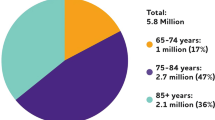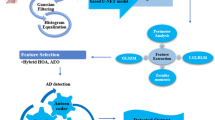Abstract
Neuroimaging-based brain age prediction using deep learning is gaining popularity. However, few studies have attempted to leverage diffusion tensor imaging (DTI) to predict brain age. In this study, we proposed a 3D convolutional neural network model (3DCNN) and trained it on fractional anisotropy (FA) data from six publicly available datasets (n = 2406, age = 17–60) to estimate brain age. Implementing a two-loop nested cross-validation scheme with a tenfold cross-validation procedure, we achieved a robust prediction performance of a mean absolute error (MAE) of 2.785 and a correlation coefficient of 0.932. We also employed Grad-Cam++ to visualize the salient features of the proposed model. We identified a few highly salient fiber tracts, including the genu of corpus callosum and the left cerebellar peduncle, among others that play a pivotal role in our model. In sum, our model reliably predicted brain age and provided novel insight into age-related changes in brains’ axonal structure.
Graphical Abstract






Similar content being viewed by others
References
O’Sullivan M et al (2001) Evidence for cortical “disconnection” as a mechanism of age-related cognitive decline. Neurology 57:4. https://doi.org/10.1212/WNL.57.4.632
Greicius MD et al (2018) Functional connectivity in the resting brain: a network analysis of the default mode hypothesis. Proceed Nat Acad Sci United States of America 100(1):253–258. https://doi.org/10.1073/pnas.0135058100
Davis SW et al (2009) Assessing the effects of age on long white matter tracts using diffusion tensor tractography. Neuroimage 46(2):530–541. https://doi.org/10.1016/j.neuroimage.2009.01.068
Cole JH et al (2019) Brain age and other bodily “ages”: implications for neuropsychiatry. Molecular Psychiatry 24:266–281. https://doi.org/10.1038/s41380-018-0098-1
Huang TW et al (2017) Age estimation from brain MRI images using deep learning. in IEEE International Symposium on Biomedical Imaging. https://doi.org/10.1109/ISBI.2017.7950650
Cherubini A et al (2016) Importance of multimodal MRI in characterizing brain tissue and its potential application for individual age prediction. Biomed Health Informatics, IEEE J 20(5):1232–1239. https://doi.org/10.1109/jbhi.2016.2559938
Abrol A et al (2021) Deep learning encodes robust discriminative neuroimaging representations to outperform standard machine learning. Nature Comm 12(1):1–17. https://doi.org/10.1038/s41467-020-20655-6
Sarker IH (2021) Deep learning: a comprehensive overview on techniques, taxonomy, applications and research directions. SN computer science 2(6):420. https://doi.org/10.20944/preprints202108.0060.v1
Xin J et al (2019) Brain differences between men and women: evidence from deep learning. Front neurosci 13:185. https://doi.org/10.3389/fnins.2019.00185
Feng X et al (2019) Estimating brain age based on a healthy population with deep learning and structural MRI. arXiv preprint arXiv:1907.00943. https://doi.org/10.48550/arXiv.1907.00943.
Cole JH et al (2017) Predicting brain age with deep learning from raw imaging data results in a reliable and heritable biomarker. NeuroImage 163:115–124. https://doi.org/10.1016/j.neuroimage.2017.07.059
Feng X et al (2020) Estimating brain age based on a healthy population with deep learning and structural MRI. arXiv preprint arXiv:1907.00943. https://doi.org/https://doi.org/10.1016/j.neurobiolaging.2020.02.009
Jiang H et al (2020) Predicting brain age of healthy adults based on structural MRI parcellation using convolutional neural networks. Front Neurol 10:1346. https://doi.org/10.3389/fneur.2019.01346
Wood DA et al (2022) Accurate brain-age models for routine clinical MRI examinations. Neuroimage 249:118871. https://doi.org/10.1016/j.neuroimage.2022.118871
Peng H et al (2021) Accurate brain age prediction with lightweight deep neural networks. Medical image analysis 68:101871. https://doi.org/10.1016/j.media.2020.101871.
Levakov G et al (2020) From a deep learning model back to the brain—Identifying regional predictors and their relation to aging. Human brain mapping 41(12):3235–3252. https://doi.org/10.1002/hbm.25011
Sexton CE et al (2014) Accelerated changes in white matter microstructure during aging: a longitudinal diffusion tensor imaging study. J Neurosci 34(46):15425–15436. https://doi.org/10.1523/jneurosci.0203-14.2014
Cox SR et al (2016) Ageing and brain white matter structure in 3,513 UK Biobank participants. Nature Comm 7(1):1–13. https://doi.org/10.1038/ncomms13629
Beck D et al (2021) White matter microstructure across the adult lifespan: a mixed longitudinal and cross-sectional study using advanced diffusion models and brain-age prediction. NeuroImage 224:117441. https://doi.org/10.1016/j.neuroimage.2020.117441
Chattopadhyay A et al (2018) Grad-cam++: Generalized gradient-based visual explanations for deep convolutional networks. IEEE: 839–847. https://doi.org/10.1109/WACV.2018.00097
Mayer AR et al (2013) Functional imaging of the hemodynamic sensory gating response in schizophrenia. Human Brain Mapping 34(9):2302–2312. https://doi.org/10.1002/hbm.22065
Yan C et al (2011) Sex-and brain size–related small-world structural cortical networks in young adults: a DTI tractography study. Cerebral cortex 21(2):449–458. https://doi.org/10.1093/cercor/bhq111
Shafto MA et al (2014) The Cambridge Centre for Ageing and Neuroscience (Cam-CAN) study protocol: a cross-sectional, lifespan, multidisciplinary examination of healthy cognitive ageing. BMC neurology 14(1):1–25. https://doi.org/10.1186/s12883-014-0204-1
Van Essen DC et al (2013) The WU-Minn human connectome project: an overview. Neuroimage 80:62–79. https://doi.org/10.1016/j.neuroimage.2013.05.041
Liu W et al (2017) Longitudinal test-retest neuroimaging data from healthy young adults in southwest China. Scientific data 4(1):1–9. https://doi.org/10.1038/sdata.2017.17
Marek K et al (2011) The Parkinson progression marker initiative (PPMI). Progress in neurobiology 95(4):629–635. https://doi.org/10.1212/wnl.78.1_meetingabstracts.p06.083
Jenkinson M et al (2012) Fsl. Neuroimage 62(2):782–790. https://doi.org/10.1016/j.neuroimage.2011.09.015
Smith SM et al (2006) Tract-based spatial statistics: voxelwise analysis of multi-subject diffusion data. Neuroimage 31(4):1487–1505. https://doi.org/10.1016/j.neuroimage.2006.02.024
Mori S et al (2006) MRI atlas of human white matter. Am JNeuroradiol 7(6):1384
Chen L-C et al (2017) Deeplab: semantic image segmentation with deep convolutional nets, atrous convolution, and fully connected crfs. IEEE Transact Pattern Anal Machine Intelligence 40(4):834–848. https://doi.org/10.1109/tpami.2017.2699184
Varoquaux G et al (2017) Assessing and tuning brain decoders: cross-validation, caveats, and guidelines. NeuroImage 145:166–179. https://doi.org/10.1016/j.neuroimage.2016.10.038
Kingma DP, Ba J (2014) Adam: a method for stochastic optimization. arXiv preprint arXiv:1412.6980. https://doi.org/https://doi.org/10.48550/arXiv.1412.6980
Abadi M et al (2016) Tensorflow: large-scale machine learning on heterogeneous distributed systems. arXiv preprint arXiv:1603.04467. https://doi.org/https://doi.org/10.48550/arXiv.1603.04467
Smith SM, Nichols TE (2009) Threshold-free cluster enhancement: addressing problems of smoothing, threshold dependence and localisation in cluster inference. Neuroimage 44(1):83–98. https://doi.org/10.1016/j.neuroimage.2008.03.061
Caliński T, Harabasz J (1974) A dendrite method for cluster analysis. Comm Statistics-Theory Methods 3(1):1–27. https://doi.org/10.1080/03610927408827101
He K et al (2016) Deep residual learning for image recognition. In: Proceedings of the IEEE conference on computer vision and pattern recognition, pp 770–778
Bennett IJ, Madden DJ (2014) Disconnected aging: cerebral white matter integrity and age-related differences in cognition. Neuroscience 276:187–205. https://doi.org/10.1016/j.neuroscience.2013.11.026
Giorgio A et al (2010) Age-related changes in grey and white matter structure throughout adulthood. Neuroimage 51(3):943–951. https://doi.org/10.1016/j.neuroimage.2010.03.004
Marstaller L et al (2015) Aging and large-scale functional networks: white matter integrity, gray matter volume, and functional connectivity in the resting state. Neuroscience 290:369–378. https://doi.org/10.1016/j.neuroscience.2015.01.049
Mwangi B, Hasan KM, Soares JC (2013) Prediction of individual subject’s age across the human lifespan using diffusion tensor imaging: a machine learning approach. Neuroimage 75:58–67. https://doi.org/10.1016/j.neuroimage.2013.02.055
Knyazeva MG (2013) Splenium of corpus callosum: patterns of interhemispheric interaction in children and adults. Neural plasticity 2013:1–12. https://doi.org/10.1155/2013/639430
Kanaan RA et al (2016) White matter microstructural organization is higher with age in adult superior cerebellar peduncles. Frontiers Aging Neurosci 8:71. https://doi.org/10.3389/fnagi.2016.00071
Raghavan S et al (2020) Reduced fractional anisotropy of the genu of the corpus callosum as a cerebrovascular disease marker and predictor of longitudinal cognition in MCI. Neurobiology Aging 96:176–183. https://doi.org/10.1016/j.neurobiolaging.2020.09.005
Fellgiebel A et al (2008) Functional relevant loss of long association fibre tracts integrity in early Alzheimer’s disease. Neuropsychologia 46(6):1698–1706. https://doi.org/10.1016/j.neuropsychologia.2007.12.010
Pareek V, Rallabandi VS, Roy PK (2018) A Correlational study between microstructural white matter properties and macrostructural gray matter volume across normal ageing: conjoint DTI and VBM analysis. Magnetic Resonance Insights. https://doi.org/10.1177/1178623x18799926
Chiang M-C et al (2011) BDNF gene effects on brain circuitry replicated in 455 twins. Neuroimage 55(2):448–454. https://doi.org/10.1016/j.neuroimage.2010.12.053
Lebel C, Beaulieu C (2011) Longitudinal development of human brain wiring continues from childhood into adulthood. J Neurosci 31(30):10937–10947. https://doi.org/10.1523/jneurosci.5302-10.2011
Kochunov P et al (2009) Loss of cerebral white matter structural integrity tracks the gray matter metabolic decline in normal aging. Neuroimage 45(1):17–28. https://doi.org/10.1016/j.neuroimage.2008.11.010
Glahn DC et al (2013) Genetic basis of neurocognitive decline and reduced white-matter integrity in normal human brain aging. Proceed Nat Acad Sci 110(47):19006–19011. https://doi.org/10.1073/pnas.1313735110
Kochunov P et al (2009) Analysis of genetic variability and whole genome linkage of whole-brain, subcortical, and ependymal hyperintense white matter volume. Stroke 40(12):3685–3690. https://doi.org/10.1161/strokeaha.109.565390
Bendlin BB et al (2010) White matter in aging and cognition: a cross-sectional study of microstructure in adults aged eighteen to eighty-three. Developmental Neuropsychol 35(3):257–277. https://doi.org/10.1080/87565641003696775
Chen C-L et al (2020) Generalization of diffusion magnetic resonance imaging–based brain age prediction model through transfer learning. NeuroImage 217:116831. https://doi.org/10.1016/j.neuroimage.2020.116831
Kumar R et al (2013) Brain axial and radial diffusivity changes with age and gender in healthy adults. Brain research 1512:22–36. https://doi.org/10.1016/j.brainres.2013.03.028
Niu X et al (2020) Improved prediction of brain age using multimodal neuroimaging data. Human brain mapping 41(6):1626–1643. https://doi.org/10.1002/hbm.24899
Acknowledgements
Data used in this article were obtained from the Center Of Biomedical Research Excellence (COBRE, available at http://schizconnect.org/), the Beijing Normal University, State Key Laboratory of Cognitive Neuroscience and Learning Enhanced Sample (Beijing-Enhanced, available at http://fcon_1000.projects.nitrc.org/indi/retro/BeijingEnhanced.html), the Cambridge Centre for Ageing and Neuroscience (Cam-CAN, available at https://www.cam-can.org/index.php?content=dataset), the Human Connectome Project (HCP, available at http://db.humanconnectome.org/), the Parkinson’s Progression Markers Initiative (PPMI, available at https://ida.loni.usc.edu/login.jsp?project=&page=HOME), and the Southwest University Longitudinal Imaging Multimodal Brain Data Repository (SLIM, available at http://fcon_1000.projects.nitrc.org/indi/retro/southwestuni_qiu_index.html).
This work was supported in part by the High Performance Computing Center of Central South University.
Funding
YT is supported by grant MIMS20-08 from the Research Fund of Guangxi Key Lab of Multi-source Information Mining & Security.
Author information
Authors and Affiliations
Corresponding authors
Ethics declarations
Competing interests
The authors declare no competing interests.
Additional information
Publisher's Note
Springer Nature remains neutral with regard to jurisdictional claims in published maps and institutional affiliations.
Supplementary Information
Below is the link to the electronic supplementary material.
Rights and permissions
Springer Nature or its licensor (e.g. a society or other partner) holds exclusive rights to this article under a publishing agreement with the author(s) or other rightsholder(s); author self-archiving of the accepted manuscript version of this article is solely governed by the terms of such publishing agreement and applicable law.
About this article
Cite this article
Wang, Y., Wen, J., Xin, J. et al. 3DCNN predicting brain age using diffusion tensor imaging. Med Biol Eng Comput 61, 3335–3344 (2023). https://doi.org/10.1007/s11517-023-02915-x
Received:
Accepted:
Published:
Issue Date:
DOI: https://doi.org/10.1007/s11517-023-02915-x




